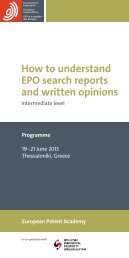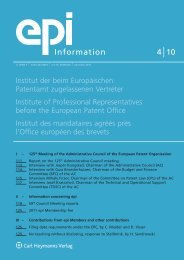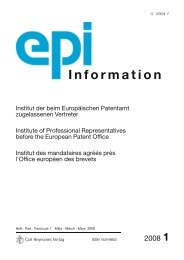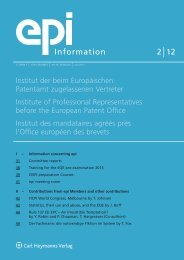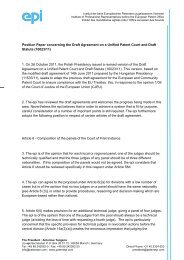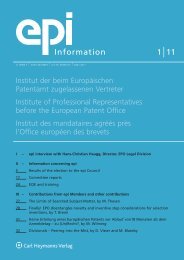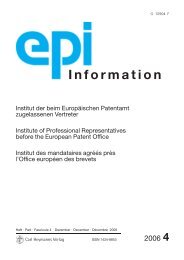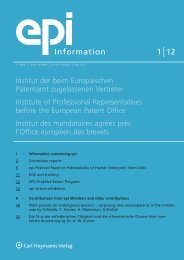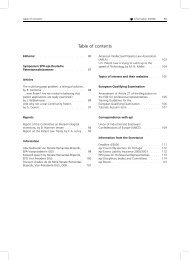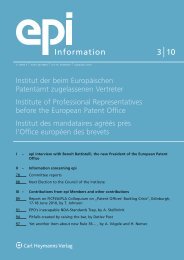epi Information 2/2009
epi Information 2/2009
epi Information 2/2009
Create successful ePaper yourself
Turn your PDF publications into a flip-book with our unique Google optimized e-Paper software.
<strong>Information</strong> 2/<strong>2009</strong> Articles 65<br />
divisional applications in this respect. Above all such a<br />
prohibition would require a legal basis.“<br />
And, we add, equally invidious to distinguish between<br />
the divisional situation and that of double patenting<br />
where, as in the parent/divisional pairing, there is no<br />
difference of date. 6<br />
More recently decision T 307/03 has confronted<br />
double patenting head-on, but in a manner which can<br />
be severely criticized. 7<br />
The facts were peculiar, and lend force to the cynical<br />
old saying of English lawyers „Hard cases make bad<br />
law“.<br />
The application was a divisional. Its parent was in due<br />
course granted but then revoked in opposition. That<br />
revocation has been appealed and at the time of writing<br />
the appeal is pending under number T 334/07.<br />
Meanwhile the divisional application was refused by<br />
the Examining division for lack of novelty (of no relevance<br />
to the present discussion) and once this appeal, T<br />
307/03, had been launched against that refusal, new<br />
claims were introduced into the divisional which effectively<br />
identically reproduced the revoked claims of the<br />
parent.<br />
It is hardly surprising that the Board intensely disliked<br />
this course of action; as it pointed out (Reasons 3.2) the<br />
applicant/patentee was attempting to appeal against the<br />
revocation of the parent without the participation of the<br />
opponent. But how to deal with it?<br />
The Board could have stayed this appeal to await the<br />
outcome of the other, or possibly could have consolidated<br />
the two.<br />
Instead, the Board chose to base itself on A60(1) EPC.<br />
After quoting the opening words of the Article in all<br />
three official languages:<br />
„The right to a European patent shall belong to the<br />
inventor or his successor in title“, „Das Recht auf das<br />
europäische Patent steht dem Erfinder oder seinem<br />
Rechtsnachfolger zu.“ „Le droit au brevet européen<br />
appartient à l’inventeur ou à son ayant cause.“<br />
the Board then said:<br />
„From this the Board deduces that under the EPC the<br />
principle of prohibition of double patenting applies and<br />
that the inventor (or his successor in title) has a right to<br />
the grant of one and only one patent from the European<br />
Patent Office for a particular invention as defined in a<br />
particular claim.“<br />
When it quoted the Article the Board apparently failed<br />
to notice that both the French and German texts clearly<br />
refer to the European patent – the one under consideration.<br />
There can be no doubt whatsoever that this<br />
Article is dealing with the question „Who owns the right<br />
6 Note that T 307/03 also seems not to limit its view to the situation of<br />
divisional applications as reference is made to applications having the same<br />
priority date, see reasons 2.3 and 2.5.<br />
7 Please also note the comments on T 307/03 by Privat Vigand in: JurisClasseur<br />
Propriété Industrielle N°5, mai <strong>2009</strong> page 43-45, „Interdiction de la double<br />
protection (double patenting)“ as well as the one by Derk Visser in Mitt.<br />
5/<strong>2009</strong>. Stimulating discussions between TB and Derk are thankfully acknowledged.<br />
to this patent?“, and has nothing to do with questions<br />
of patentability.<br />
The Board then continues:<br />
„Once a patent has been granted to the inventor (or his<br />
successor in title) this right to a patent has been<br />
exhausted, and the European Patent Office is entitled<br />
to refuse to grant a further patent to the inventor (or his<br />
successor in title) for the subject-matter for which he has<br />
already been granted a patent.“<br />
This echoes decision T 998/99 (exhaustion of priority<br />
right) where a Board construed the English „a“ to mean<br />
„one only“ (ne bis in idem). An English legislator with<br />
that intention would say explicitly „one“ or „one only“.<br />
Just as decision T 998/99 has been criticized 8 (see e.g.<br />
T 15/01 and T 5/05) so can the present decision be<br />
criticized in this respect also?<br />
The Board in T 307/03 then acknowledges that there is<br />
no express provision in the EPC dealing with double<br />
patenting, points out that some national legislations do<br />
have such a prohibition and quotes by way of example<br />
S18(5) of the United Kingdom Patents Act („UKPA“)<br />
1977. We shall return to its text later. The Board then<br />
argues that<br />
„… double patenting is expensive and most patent<br />
proprietors would not wish to incur the expense. The<br />
legislator cannot be expected to have made provisions to<br />
regulate what will on grounds of economics alone be a<br />
very rare occurrence.“<br />
It is not clear why the European legislator cannot be<br />
expected to legislate in such a very rare case when the<br />
national one has, but there is a stronger argument a<br />
contrario. If there is national legislation but no European,<br />
is that not indicative of a deliberate omission on the<br />
European level? See also the Travaux Préparatoires at the<br />
places given above. Furthermore, is the Board not holding<br />
that A60 is such legislation?<br />
What is double patenting?<br />
In all this discussion so far neither we, nor the Boards,<br />
have decided what double patenting is; even in T 307/03<br />
there are two different suggestions. One is found in<br />
Reasons 2.3:<br />
„….two or more identical patents with the same claims<br />
and the same priority dates….“<br />
and another in Reasons 2.1:<br />
„… a further patent to the inventor (or his successor in<br />
title) for the subject-matter for which he has already<br />
been granted a patent“.<br />
The latter includes the case where one patent includes<br />
any part of the subject matter of the other. Consistently<br />
with this T 307/03 goes on to criticize T 587/98for<br />
allowing „conflicting claims“ to coexist in parent and<br />
divisional.<br />
8 See Bremi and Liebetanz, „Kann man ein Prioritätsrecht „verbrauchen“?“,<br />
Mitteilungen der deutschen Patentanwälte, 4/2004, p. 148ff.. as well as<br />
Bremi and Liebetanz, „No exhaustion of priority rights!?“, <strong>epi</strong> <strong>Information</strong>,<br />
4/2005, S. 139.



